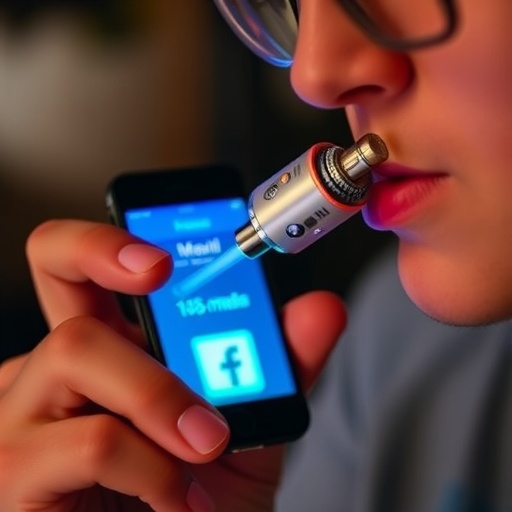In recent years, the rising prominence of e-cigarettes has raised concerns among health professionals and policymakers alike, especially regarding their influence on younger populations. A groundbreaking study published in the International Journal of Mental Health and Addiction in 2025 sheds new light on the complex dynamics behind U.S. adolescents’ exposure to e-cigarette-related content on social media platforms. Through meticulous research, this study unpacks the multifaceted factors shaping how young people encounter and interact with vaping-related messages online, pointing to significant implications for public health strategies.
The landscape of social media has evolved into a dominant force dictating trends, opinions, and behaviors among adolescents. Platforms like Instagram, TikTok, Snapchat, and YouTube serve as hotspots for content sharing and consumption that often blur the lines between advertising, peer influence, and personal expression. Within this digital ecosystem, e-cigarette content has found fertile ground to proliferate. The study highlights that the extent of adolescents’ exposure to vaping-related content is not merely a consequence of passive scrolling but is deeply tied to algorithmic designs, peer networks, and targeted marketing tactics that amplify such messages.
One of the most technically fascinating aspects the research illuminates is the role of social media algorithms. These digital gatekeepers curate content feeds based on user behavior, preferences, and engagement history, creating echo chambers that reinforce existing interests. Adolescents who start interacting with e-cigarette content—whether by liking posts, watching videos, or following influencers—are algorithmically propelled into increasingly dense webs of similar material. This feedback loop exacerbates exposure, making it challenging for young users to escape the pervasive presence of e-cigarette promotions disguised as lifestyle or entertainment content.
Moreover, the study delves into influencer marketing’s pivotal role in shaping adolescents’ perceptions of vaping. Unlike traditional advertising, which tends to be overt and regulated, influencers often embed promotional messages within relatable and aspirational content, lending e-cigarettes an aura of social acceptance and desirability. The authors emphasize that such covert marketing strategies exploit the nuanced psychology of adolescent identity formation and peer belonging, making young individuals particularly susceptible to these messages. This subtlety significantly complicates efforts to regulate e-cigarette promotion on social media platforms.
Crucially, the research underscores the intersectionality between demographic factors and social media engagement with e-cigarette content. Gender, socio-economic status, and cultural background emerge as important determinants influencing not only exposure levels but also the nature of adolescents’ engagement. For instance, male adolescents and those from lower socio-economic backgrounds were found to engage more frequently with vaping content, suggesting targeted vulnerabilities that may require tailored public health interventions. Understanding these nuances allows for a more precise and effective allocation of resources to combat youth vaping.
Beyond direct marketing and algorithms, peer influence remains a formidable force affecting adolescents’ engagement with e-cigarette content. The study illustrates how social circles on social media platforms create environments where vaping is normalized or even glamorized. Peer-shared content, user-generated videos, and discussions contribute to a collective social script that can obscure the known health risks associated with e-cigarettes. This peer-driven dynamic complicates straightforward public health messaging, as adolescents often prioritize peer approval over authoritative guidance.
The researchers also analyze the psychological impact of such digital engagement. Extended exposure and interaction with e-cigarette content can subtly alter adolescents’ attitudes and risk perceptions related to vaping. The normalization and glamorization of e-cigarettes on social media may diminish the perceived harm, increasing the likelihood of initiation and continued use. This psychological dimension points to an urgent need for counter-messaging strategies that resonate within the social media environment and effectively counteract the appeal of vaping.
Technological innovation has facilitated the creation of highly immersive and interactive content, which intensifies its influence. Augmented reality filters, immersive storytelling, and participatory challenges related to vaping increase the stickiness of e-cigarette content among adolescents. The study brings to attention how these cutting-edge content formats are employed to captivate youth, often circumventing conventional regulatory frameworks designed for traditional advertisements. These technological advancements pose fresh challenges for public health practitioners aiming to mitigate vaping uptake among the youth.
One of the dominant frameworks emerging from the study is the importance of digital literacy education as a preventative tool. By empowering adolescents with critical thinking skills and awareness about the mechanics of social media algorithms and influencer marketing strategies, young users can become more discerning consumers of content. Digital literacy interventions can diminish the persuasive impact of e-cigarette content, aiding adolescents in recognizing and resisting covert promotional tactics. The study strongly advocates for integrating digital literacy into school curriculums to build resilience against irresponsible marketing.
The research methods employed in this study are noteworthy for their interdisciplinarity. Combining quantitative analysis of social media engagement data with qualitative interviews and surveys, the researchers constructed a comprehensive picture of adolescents’ online vaping-related behavior. The methodological rigor demonstrates the importance of utilizing mixed methods to capture the complexities of digital interactions that involve behavioral, psychological, and sociological components. This model of research can serve as a blueprint for future studies addressing other health-related topics in the rapidly evolving digital landscape.
Another striking finding revealed by the study is that not all e-cigarette-related content has uniform influence. Variations in content tone—ranging from purely promotional to harm-reduction focused or even anti-vaping messages—modulate adolescents’ responses. The study found that positively framed content or that portraying vaping as a social norm had a stronger impact on behavior, while health-focused warnings often fail to penetrate deeply within the social media environment. This nuanced understanding underscores the importance of strategic content design when crafting public health campaigns.
The legal and regulatory challenges surrounding e-cigarettes on social media are also examined in detail. The study explores how regulatory bodies struggle to keep pace with the rapid evolution of digital marketing techniques. Current policies often lack the sophistication to address influencer endorsements, algorithmic amplifications, and peer-driven content dissemination. This mismatch enables the continued proliferation of e-cigarette content among adolescents despite restrictions on traditional advertising. The authors call for urgent updates to regulatory frameworks that are technologically informed and enforceable across digital platforms.
Importantly, the study situates its findings within the broader public health context, emphasizing the potential long-term consequences of adolescent vaping. The increasing use of e-cigarettes among youth has been linked to nicotine addiction, respiratory issues, and a potential gateway effect to combustible tobacco products. By identifying the mechanisms driving social media exposure and engagement, this research provides crucial insights for designing interventions that can effectively curtail e-cigarette uptake before these health problems become endemic among new generations.
In conclusion, the study portrays a digital battleground where the interests of public health often clash with the commercial imperatives of the e-cigarette industry and the engaging allure of social media content. Understanding the technological underpinnings, psychological mechanisms, and social dynamics that govern adolescents’ exposure and engagement with vaping content is indispensable for crafting innovative solutions. As social media remains integral to adolescent life, efforts to mitigate vaping-related harms must evolve to address this digital reality with creativity and precision.
This pioneering research marks a significant step forward in the fight against youth vaping by opening up a critical area of inquiry filled with complexities that demand urgent attention. The intersection of evolving technology, adolescent psychology, social influence, and public health policy depicted here will undoubtedly shape the future trajectory of anti-vaping initiatives. Empowering adolescents with tools to navigate this digital landscape while updating regulatory measures is essential to stemming the tide of e-cigarette use and securing healthier futures.
Subject of Research: Factors influencing exposure and engagement of US adolescents with e-cigarette-related content on social media.
Article Title: Factors Influencing US Adolescents’ Exposure and Engagement with E-Cigarette-Related Content on Social Media.
Article References:
Ahuja, N.A., Mahmood, A., Kedia, S.K. et al. Factors Influencing US Adolescents’ Exposure and Engagement with E-Cigarette-Related Content on Social Media. Int J Ment Health Addiction (2025). https://doi.org/10.1007/s11469-025-01547-6
Image Credits: AI Generated
Tags: digital marketing and youth behaviore-cigarette social media influencehealth implications of teen vapingonline behavior and addictionpeer influence on e-cigarette usesocial media algorithms and vapingsocial media platforms and teen health risksTikTok impact on teen healthU.S. adolescents vaping trendsvaping and public health strategiesvaping-related content on Instagramyouth exposure to e-cigarette advertising




